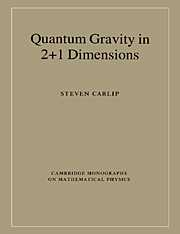Book contents
- Frontmatter
- Contents
- Preface
- 1 Why (2+1)-dimensional gravity?
- 2 Classical general relativity in 2+1 dimensions
- 3 A field guide to the (2+1)-dimensional spacetimes
- 4 Geometric structures and Chern–Simons theory
- 5 Canonical quantization in reduced phase space
- 6 The connection representation
- 7 Operator algebras and loops
- 8 The Wheeler–DeWitt equation
- 9 Lorentzian path integrals
- 10 Euclidean path integrals and quantum cosmology
- 11 Lattice methods
- 12 The (2+1)-dimensional black hole
- 13 Next steps
- Appendix A The topology of manifolds
- Appendix B Lorentzian metrics and causal structure
- Appendix C Differential geometry and fiber bundles
- References
- Index
Appendix B - Lorentzian metrics and causal structure
Published online by Cambridge University Press: 15 December 2009
- Frontmatter
- Contents
- Preface
- 1 Why (2+1)-dimensional gravity?
- 2 Classical general relativity in 2+1 dimensions
- 3 A field guide to the (2+1)-dimensional spacetimes
- 4 Geometric structures and Chern–Simons theory
- 5 Canonical quantization in reduced phase space
- 6 The connection representation
- 7 Operator algebras and loops
- 8 The Wheeler–DeWitt equation
- 9 Lorentzian path integrals
- 10 Euclidean path integrals and quantum cosmology
- 11 Lattice methods
- 12 The (2+1)-dimensional black hole
- 13 Next steps
- Appendix A The topology of manifolds
- Appendix B Lorentzian metrics and causal structure
- Appendix C Differential geometry and fiber bundles
- References
- Index
Summary
In general relativity we are interested in both the topology and the geometry of spacetime. The body of this book concentrates on geometrical issues in (2+1)-dimensional gravity and their physical implications, while appendix A introduces some basic topological concepts. The purpose of this appendix is to briefly discuss a set of issues intermediate between topology and geometry: issues of the large scale structure, and in particular the causal structure, of a spacetime with a Lorentzian metric.
Questions of large scale structure have played a very important role in recent work in (3+1)-dimensional general relativity, leading to general theorems about singularities, causality, and topology change. A thorough discussion is given in reference (see also). Many of these general results have not yet been applied to 2+1 dimensions, and I shall not attempt to review them here; my aim is merely to introduce the ideas that have already found a use in (2+1)-dimensional gravity.
Lorentzian metrics
To specify a spacetime, we need a manifold M with a Lorentzian metric, that is (in three dimensions) a metric g of signature (− + +). Such a metric determines a light cone at each point in M. A spacetime M is time-orientable if a continuous choice of the future light cone can be made, that is, if there is a global distinction between the past and future directions. Similarly, M is space-orientable if there is a global distinction between left- and right-handed spatial coordinate frames.
- Type
- Chapter
- Information
- Quantum Gravity in 2+1 Dimensions , pp. 236 - 242Publisher: Cambridge University PressPrint publication year: 1998

